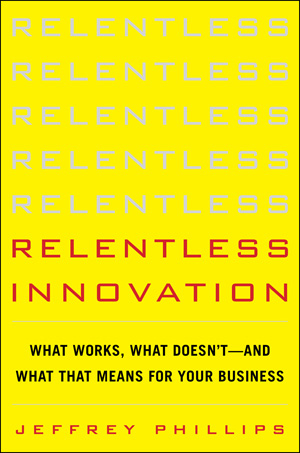Insights into Innovation
An alumnus describes his discoveries about what blocks change in companies
I’ve been working as an innovation consultant for close to a decade, helping clients create new products and services. When CEOs are surveyed about what’s important to them, innovation is always a top priority, yet few firms seem very innovative. The National Science Foundation published a research paper in 2008 demonstrating how little innovation is actually accomplished. It found that over three years, only 20 percent of manufacturing firms and 8 percent of services firms created products and services that were “innovative.” There’s a gap between what executives want and what businesses produce where innovation is concerned. The reason for this gap became clear to me about two years ago when I was leading a project with a credit card company. Our team had generated several compelling ideas, and we were reviewing them with a senior vice president. He agreed the ideas were valuable and disruptive, and then said, “But the BAU won’t let you do these.” Having been a consultant most of my working life, I thought I knew all the acronyms, but BAU was new to me. “BAU?” I said. “Business as usual,” he replied. Using shorthand, he was telling me the formal and informal processes, perspectives, methods, frameworks and other explicit and implicit agreements that form the operating model for his company would block innovation. That simple point was actually fairly profound. I realized that most businesses have built very effective, very efficient operating models that assure consistency, repeatability and short term profitability. These efficient, effective models, which he called “business as usual”, are strangling innovation efforts.

This raises an interesting question: How can an organization that’s structured to produce consistent, reliable, efficient results also embrace innovation, which is uncertain, unpredictable, disruptive and inefficient? Can a firm be simultaneously efficient and innovative? I think they must. In my experience, innovation is important for almost any firm, because the pace of change is increasing, global trade is increasing, customers’ expectations of new products and services is growing, and the cost of entry into many markets has fallen. These factors contribute to much faster product obsolescence. As products and services become commoditized and product life cycles shorten, innovation must accelerate. But innovation conflicts with all of the investments in efficiency and effectiveness, and threatens to distract the firm from short term obligations. How does a firm that has invested in building an efficient, effective operating model shift gears to incorporate more innovation? Innovation threatens to disrupt the operating model by introducing new and risky concepts, uncertain goals and outcomes. Further, it distracts limited resources from the work a company knows best. It’s this dichotomy that reminds me of the value of my education at the University of Virginia. While I was nominally an engineer, I spent practically as much time in the College and in the McIntire School, receiving a very broad education that shaped my thinking. I’d like to think that the engineering school taught me how to solve challenging, technical problems, while the College and the McIntire experience broadened and enriched my perspectives. It’s this “both/and” aspect of the Virginia education that is so desperately needed in many organizations. Managers are constantly confronted with difficult decisions that seem mutually exclusive. Broader, systems-based thinkers are needed to address those challenges.

In the research for my book, Relentless Innovation, I found that leading innovators—specifically 3M, Google, Apple, Gore, P&G—balance efficiency and innovation. These firms are innovation leaders, but they are also as efficient as their close competitors in terms of their use of inputs and resources. They demonstrate it is possible to simultaneously create and commercialize interesting valuable new products and services while sustaining an efficient, effective framework for profitability. What’s more, these companies have sustained innovation for decades. Many firms innovate occasionally or sporadically based on customer needs or market threats, but 3M, Google, Apple and others I’ve mentioned have been consistently creating interesting products and services for years, using a framework we call “innovation business as usual.” These firms incorporate in their processes, decision making frameworks and in their corporate culture the concept that innovation is an everyday occurrence that is expected, rather than a disruption to be feared. Clearly, creating an “innovation business as usual” perspective means changing how a firm makes decisions, what it emphasizes, how it evaluates ideas and projects. This means that the most important role to adjust is that of the middle manager. In most businesses, middle managers are the efficiency experts, striving to obtain the best outputs from limited inputs and achieve quarterly financial results. As management tools like Lean, Six Sigma, outsourcing and right-sizing have honed the operating models, middle managers have become experts at doing more with fewer resources and less funding. But a firm cannot shrink its way to growth and differentiation. There’s little question that innovation will drive far more growth and differentiation, and that innovation is rapidly becoming a core competence rather than a nice one to have. Innovative firms recognize that their operating models must shift from an overwhelming focus on efficiency to a model balanced between efficiency and innovation.